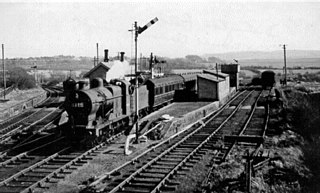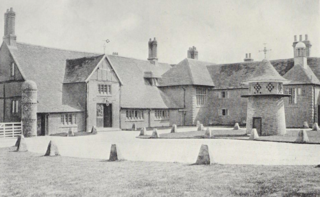
Lieutenant Colonel Albert Leigh Abbott MC TD FRIBA (1890 - 1952) was an architect based in London. [1]

Lieutenant Colonel Albert Leigh Abbott MC TD FRIBA (1890 - 1952) was an architect based in London. [1]
He won a travelling studentship in 1913.
He was Inspector of Housing for the Ministry of Health from 1920-21. He worked for local authorities in the construction of council houses and also designed many large houses for individual clients.
He was appointed LRIBA in 1925 and FRIBA in 1931. [1]
He entered into a partnership with Y.J. Lovell and Son and Douglas Tanner as Lovell, Abbott and Tanner.
Later he set up new partnership of A.L. Abbott & Partners (William Beswick and Geoffrey Richard Shires) and this was dissolved on 1 November 1952 [2] shortly before his death.
He was born in 1890 in Hendon, London, the son of John Abbott (1852-1932) and Emma Rowe (1852 - 1923).
He married Alice Elizabeth Hudson (1893-1981) on 5 January 1918 in St Margaret's Church, Westminster. They had three children.
He died on 13 December 1952 at his home at 15 College Road, West Dulwich when his car caught fire in his garage. [3]
In the First World War he served as a Corporal in the London Regiment and on 21 August 1915 he was commissioned into the London Divisional Engineers before later being transferred to the Corps of Royal Engineers in the Territorial Army where he was awarded the Military Cross in 1918. [4]
He reached the rank of Major in 1920 which was confirmed in 1926. [5] and in 1933 he was promoted from Major to Lieutenant Colonel. [6]

Sir Edwin Landseer Lutyens was an English architect known for imaginatively adapting traditional architectural styles to the requirements of his era. He designed many English country houses, war memorials and public buildings. In his biography, the writer Christopher Hussey wrote, "In his lifetime (Lutyens) was widely held to be our greatest architect since Wren if not, as many maintained, his superior". The architectural historian Gavin Stamp described him as "surely the greatest British architect of the twentieth century".

Leighton Buzzard is a market town in Bedfordshire, England, in the southwest of the county and close to the Buckinghamshire border. It lies between Aylesbury, Tring, Luton/Dunstable and Milton Keynes, near the Chiltern Hills.

The Military Cross (MC) is the third-level military decoration awarded to officers and other ranks of the British Armed Forces, and formerly awarded to officers of other Commonwealth countries.

Cumberland Terrace is a neoclassical terrace on the eastern side of Regent's Park in the London Borough of Camden, completed in 1826. It is a Grade I listed building.
Eaton Bray was a rural district in Bedfordshire, England from 1894 to 1933.

Alfred Charles Bossom, Baron Bossom GCStJ FRIBA was an architect in the United States who returned to his native England and became a Conservative Party politician. He also wrote books on architecture.
Walter Hindes Godfrey, CBE, FSA, FRIBA (1881–1961), was an English architect, antiquary, and architectural and topographical historian. He was also a landscape architect and designer, and an accomplished draftsman and illustrator. He was (1941–60) the first director and the inspiration behind the foundation of the National Buildings Record, the basis of today's Historic England Archive, and edited or contributed to numerous volumes of the Survey of London. He devised a system of Service Heraldry for recording service in the European War.

This is a list of high sheriffs of Bedfordshire.
Cedars Upper School is an upper school and sixth form with academy status, located in Leighton Buzzard, Bedfordshire, England. Former students of the school are known as Old Cedarians.
Linslade was an urban district in the administrative county of Buckinghamshire, England from 1897 to 1965.
Major Thomas Francis Netterville Gerrard was a British World War I flying ace credited with ten aerial victories. He died following a post-war equestrian accident.
Captain Basil Edgar Baily FRIBA was an architect based in Nottingham. Much of his earlier work had to do with nearby churches.

Albert Victor Heal MC FRIBA was an architect and designer based in England.
Sir Gilbert Samuel Inglefield GBE TD was a British architect and Lord Mayor of London from November 1967 to November 1968.

Distington railway station was opened jointly by the Cleator and Workington Junction Railway (C&WJR) and the LNWR and Furness Joint Railway on 1 October 1879. It was situated on the northern edge of the village of Distington, Cumbria, England, where the C&WJR's north–south main line crossed the Joint Line's east–west Gilgarran Branch.
Edwin Alfred Rickards FRIBA (1872–1920) was an English architect.

Maurice Bingham Adams FRIBA (1849–1933) was a British architect in the Arts and Crafts style.

James Edwin Forbes FRIBA was an architect primarily based in London from 1905 to 1930 in partnership with John Duncan Tate.

John Duncan Tate FRIBA was an architect primarily based in London from 1905 to 1930 partnership with James Edwin Forbes.

Captain Albert Edgar Eberlin FRIBA MC was an architect based in Nottingham.